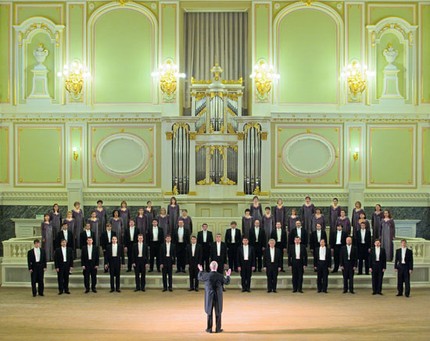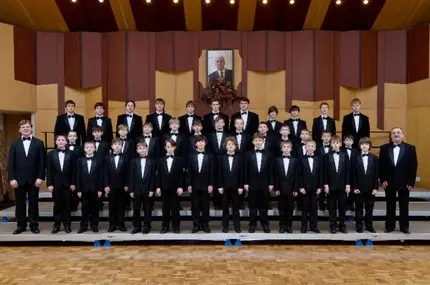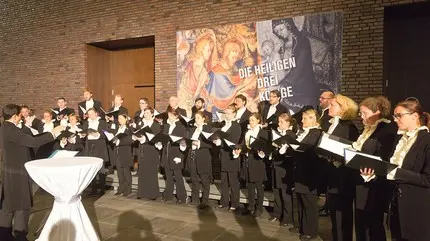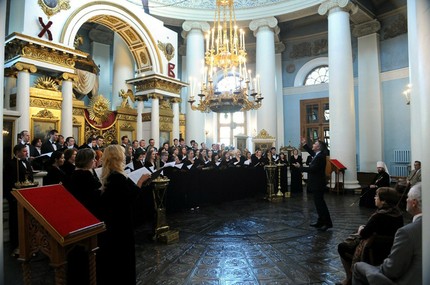
State Academic Chapel of St. Petersburg (Saint Petersburg Court Capella) |
Saint Petersburg Court Capella

The State Academic Chapel of St. Petersburg is a concert organization in St. Petersburg, which includes the oldest professional choir in Russia (founded in the XNUMXth century) and a symphony orchestra. Has its own concert hall.
The St. Petersburg Singing Chapel is the oldest Russian professional choir. Founded in 1479 in Moscow as a male choir of the so-called. sovereign choristers deacons to participate in the services of the Assumption Cathedral and in the “worldly amusements” of the royal court. In 1701 he was reorganized into the court choir (men and boys), in 1703 he was transferred to St. Petersburg. In 1717 he traveled with Peter I to Poland, Germany, Holland, France, where he first introduced Russian choral singing to foreign listeners.
In 1763 the choir was renamed into the Imperial Court Singing Chapel (100 people in the choir). Since 1742, many singers have been regular members of the choir in Italian operas, and since the middle of the 18th century. also performers of solo parts in the first Russian operas in the court theater. Since 1774, the choir has been giving concerts at the St. Petersburg Music Club, in 1802-50 it participates in all concerts of the St. Petersburg Philharmonic Society (cantatas and oratorios by Russian and foreign composers, most of which were performed in Russia for the first time, and some in the world, incl. Beethoven’s Solemn Mass, 1824). In 1850-82, the concert activity of the chapel took place mainly in the hall of the Concert Society at the chapel.
Being the center of Russian choral culture, the chapel influenced not only the formation of the traditions of choral performance in Russia, but also the style of choral writing without accompaniment (a cappella). Prominent Russian and Western contemporary musicians (V. V. Stasov, A. N. Serov, A. Adan, G. Berlioz, F. Liszt, R. Schumann, etc.) noted harmony, an exceptional ensemble, virtuoso technique, impeccable possession the finest gradations of choral sound and magnificent voices (especially bass octavists).
The chapel was headed by musical figures and composers: MP Poltoratsky (1763-1795), D. S. Bortnyansky (1796-1825), F. P. Lvov (1825-36), A. F. Lvov (1837-61), N. I. Bakhmetev (1861-83), M. A. Balakirev (1883-94), A. S. Arensky (1895-1901), S. V. Smolensky (1901-03) and others. was M. I. Glinka.
Since 1816, the directors of the chapel were granted the right to publish, edit, and authorize for performance the sacred choral works of Russian composers. In 1846-1917, the chapel had state full-time and part-time conducting (regency) classes, and from 1858 instrumental classes were opened in various orchestral specialties, which prepared (according to the programs of the conservatory) soloists and artists of the orchestra of the highest qualification.
Classes reached a special development under N. A. Rimsky-Korsakov (assistant manager in 1883-94), who in 1885 created a symphony orchestra from the students of the chapel, performing under the baton of the most prominent conductors. The teachers of the instrumental-choir classes were famous conductors, composers, and performing musicians.

In 1905-17, the activities of the chapel were limited mainly to church and cult events. After the October Revolution of 1917, the choir’s repertoire included the best examples of world choral classics, works by Soviet composers, and folk songs. In 1918, the chapel was transformed into the People’s Choir Academy, from 1922 – the State Academic Chapel (since 1954 – named after M. I. Glinka). In 1920, the choir was replenished with female voices and became mixed.
In 1922, a choir school and a day-time choral technical school were organized at the chapel (since 1925, an evening choir school for adults was also organized). In 1945, on the basis of the choir school, the Choir School was established at the choir (since 1954 – named after M. I. Glinka). In 1955 the Choral School became an independent organization.
The chapel team conducts a great concert work. Her repertoire includes classical and modern unaccompanied choirs, programs from the works of domestic composers, folk songs (Russian, Ukrainian, etc.), as well as major works of the cantata-oratorio genre, many of which were performed by the chapel in the USSR for the first time. Among them: “Alexander Nevsky”, “Guardian of the World”, “Toast” by Prokofiev; “Song of the Forests”, “The Sun Shines Over Our Homeland” by Shostakovich; “On the Kulikovo Field”, “The Legend of the Battle for the Russian Land” by Shaporin, “The Twelve” by Salmanov, “Virineya” by Slonimsky, “The Tale of Igor’s Campaign” by Prigogine and many other works by Soviet and foreign composers.
After 1917, the chapel was led by prominent Soviet choral conductors: M. G. Klimov (1917-35), H. M. Danilin (1936-37), A. V. Sveshnikov (1937-41), G. A. Dmitrevsky (1943-53), A. I. Anisimov (1955-65), F. M. Kozlov (1967-72), since 1974 – V. A. Chernushenko. In 1928 the chapel toured Latvia, Germany, Switzerland, Italy, and in 1952 the GDR.
References: Muzalevsky V.I., The oldest Russian choir. (1713-1938), L.-M., 1938; (Gusin I., Tkachev D.), State Academic Chapel named after M. I. Glinka, L., 1957; Academic Chapel named after M. I. Glinka, in the book: Musical Leningrad, L., 1958; Lokshin D., Remarkable Russian choirs and their conductors, M., 1963; Kazachkov S., Two styles – two traditions, “SM”, 1971, No 2.
D. V. Tkachev





